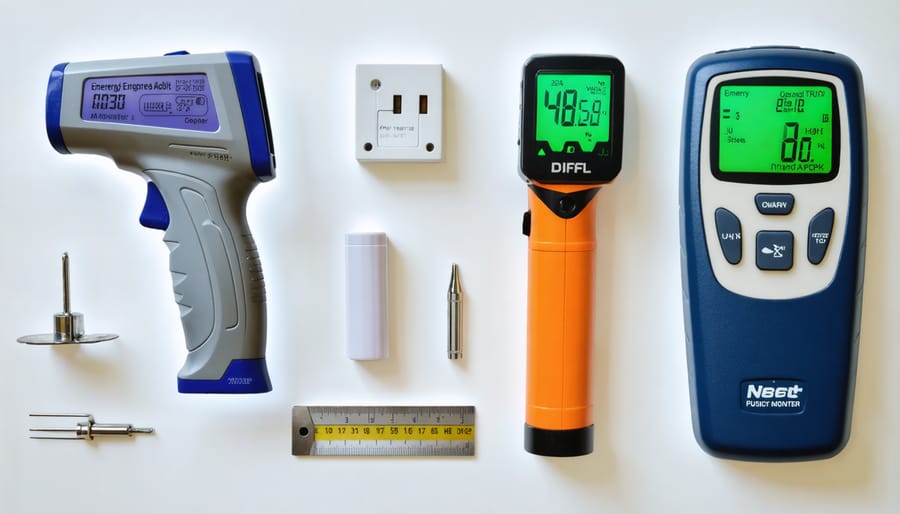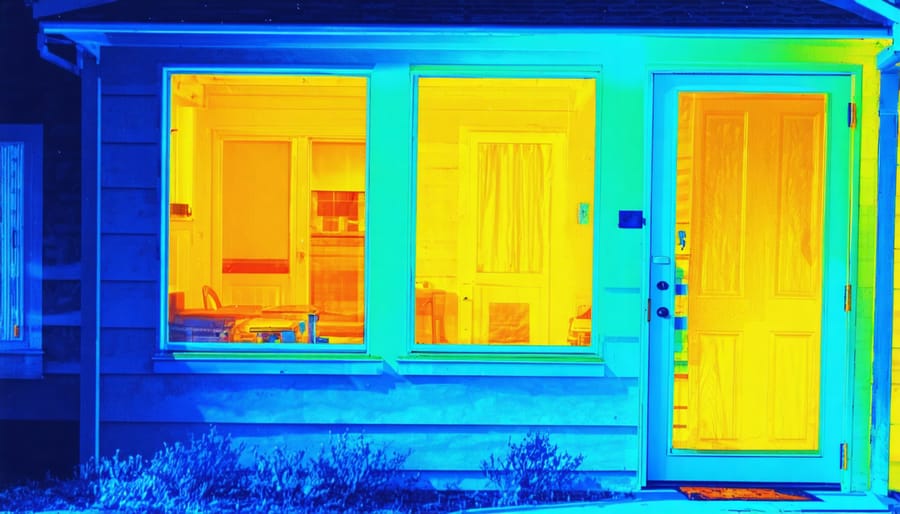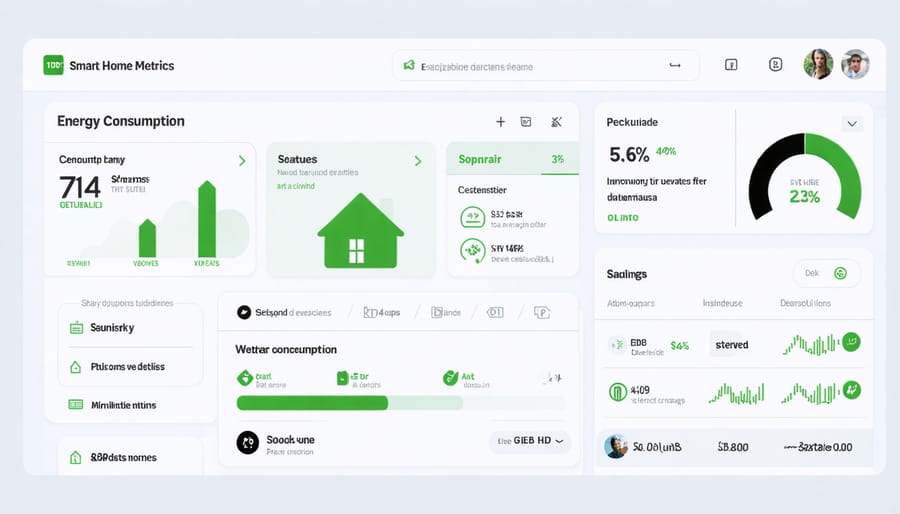Transform your monthly energy bills and boost your home’s efficiency in under 60 minutes with a DIY energy checkup. Armed with a smartphone and basic tools, identify energy-draining culprits that silently inflate your utility costs. Modern smart home technology makes it easier than ever to spot inefficiencies – from outdated HVAC systems consuming excess power to invisible air leaks around windows and doors costing you hundreds annually. Whether you’re a new homeowner or seasoned property investor, this quick assessment helps prioritize energy upgrades that deliver the highest ROI while increasing property value. Smart thermostats, LED lighting, and proper insulation often pay for themselves within months, making them attractive features for future buyers or tenants. Let’s dive into a room-by-room inspection that combines traditional energy-saving wisdom with cutting-edge home automation to maximize your property’s energy performance.
Essential Tools for Your DIY Energy Checkup

Basic Manual Tools
Several affordable and easy-to-use tools can help you conduct a basic energy assessment of your home. An infrared thermometer, typically priced between $20-50, allows you to identify temperature variations and potential insulation gaps in walls and windows. A smoke pencil or incense stick serves as a simple draft detector – watch the smoke’s movement to spot air leaks around doors, windows, and electrical outlets.
A digital moisture meter helps detect dampness in walls and ceilings that could affect your home’s energy efficiency. For electrical assessment, a plug-in energy monitor ($25-40) tracks individual appliance power consumption, helping you identify energy-hungry devices. A basic light meter can help determine if you’re over-lighting spaces, while a humidity gauge ensures optimal indoor air quality and HVAC efficiency.
These tools represent a small investment that can lead to significant energy savings over time.
Smart Home Monitoring Devices
Modern technology has revolutionized home energy monitoring through sophisticated automation tools. Smart home energy monitors and intelligent thermostats offer real-time tracking of your home’s energy consumption patterns. These devices can identify energy-hungry appliances, suggest optimal temperature settings, and even automate adjustments based on your daily routines. Smart thermostats like Nest or Ecobee learn your preferences over time, potentially reducing heating and cooling costs by 10-15% annually. Many of these devices also integrate with smartphone apps, allowing you to monitor and control your home’s energy usage remotely. For investment-minded homeowners, these smart solutions not only cut utility bills but can also increase property value by demonstrating a commitment to energy efficiency and modern home technology.
Key Areas to Check During Your Audit
HVAC System Assessment
Smart thermostats have revolutionized how we monitor and optimize HVAC performance. Start by checking your thermostat’s energy report, which typically shows monthly usage patterns and runtime hours. Look for unusual spikes in operation time, which could indicate system inefficiency or the need for maintenance.
Pay attention to temperature differentials throughout your home. If some rooms are consistently warmer or cooler than others, this might signal ductwork issues or the need for system balancing. Most smart thermostats offer zone-by-zone temperature monitoring, making this assessment easier.
Use your smart thermostat’s maintenance alerts and filter replacement reminders as a guide. A dirty filter can reduce efficiency by up to 15%. Check the outdoor unit for debris and ensure proper airflow around the unit. Listen for unusual noises during operation, which could indicate mechanical problems.
Review your system’s seasonal performance data. If cooling or heating cycles are running longer than previous years, it might be time for professional maintenance. Many smart thermostats can also calculate your system’s efficiency score, helping you decide when upgrades might be cost-effective.

Insulation and Air Leaks
Insulation and air leaks are often the biggest culprits behind energy waste in homes. Start by checking your attic insulation – it should be evenly distributed and at least 10-12 inches deep. Run your hand along walls, windows, and doors to feel for drafts. Pay special attention to areas where different building materials meet, such as corners, foundation edges, and where pipes enter the home.
Common problem areas include electrical outlets on exterior walls, baseboards, and window frames. On a windy day, hold a lit incense stick near these spots – if the smoke wavers, you’ve found an air leak. Don’t forget to inspect your HVAC ductwork, as leaky ducts can waste up to 30% of your heating and cooling energy.
Quick fixes include installing foam gaskets behind outlet covers, applying weatherstripping around doors and windows, and using door sweeps to seal gaps under exterior doors. For larger gaps, use expanding foam sealant or caulk. While these solutions are relatively inexpensive, they can lead to significant energy savings over time and improve your home’s overall comfort level.
Lighting and Appliance Review
A thorough review of your lighting and appliances can significantly reduce your energy bills while enhancing your home’s value. Start by identifying all light fixtures still using traditional incandescent bulbs – replacing these with LED alternatives can cut lighting costs by up to 75%. Pay special attention to high-usage areas like kitchens and living rooms.
For appliances, check the Energy Star ratings and manufacturing dates of your major devices. Refrigerators, washers, and HVAC systems over 10 years old typically consume significantly more energy than modern equivalents. Use a smart power meter to measure the actual consumption of plug-in devices, and don’t forget to check for phantom power draw from electronics in standby mode.
Consider installing smart plugs or a home energy monitoring system to track real-time usage. These devices can help identify energy-hungry appliances and unusual consumption patterns. For optimal savings, program your smart thermostats and automated lighting systems to adjust based on occupancy and time of day.
Smart Device Integration Check
Smart home devices can significantly impact your energy consumption, making their proper integration crucial for maximum efficiency. Start by checking your smart thermostat’s scheduling and temperature thresholds. Ensure it’s programmed to adjust automatically during peak and off-peak hours, potentially saving 10-15% on heating and cooling costs.
Review your smart lighting system’s motion sensors and timing settings. Verify that lights automatically turn off in unoccupied rooms and dim appropriately during daylight hours. Check that smart plugs controlling electronics are set to power down devices during inactive periods, eliminating phantom energy drain.
For homes with smart window treatments, confirm they’re programmed to optimize natural heating and cooling. During summer, they should close automatically during peak sun hours, while in winter, they should open to capture natural warmth.
Don’t forget to audit your smart home hub’s integration with your utility company’s demand response program. Many providers offer incentives for allowing automated adjustments during high-demand periods, which can translate to substantial savings on your energy bills.
Finally, ensure all devices are running the latest firmware updates, as these often include energy optimization improvements.
Financial Benefits and Incentives

Immediate Cost Savings
A quick home energy checkup can lead to substantial monthly savings, often with minimal upfront investment. Let’s break down the potential cost reductions based on common audit findings. On average, homeowners who implement basic energy-saving measures identified during a checkup report savings of $25-50 on their monthly utility bills.
For example, sealing air leaks around windows and doors typically saves 10-15% on heating and cooling costs. Installing a programmable thermostat can reduce HVAC expenses by approximately $180 annually. LED bulb replacements, while requiring an initial investment of about $100 for a whole house, can save up to $225 per year on electricity costs.
More significant savings come from addressing insulation issues. Proper attic insulation alone can reduce energy bills by 15-20%, translating to annual savings of $200-400 for the average home. Water heater adjustments and pipe insulation can cut water heating costs by 10%, saving another $100-200 yearly.
When combined, these improvements can result in total annual savings ranging from $500 to $1,000 for a typical single-family home. The best part? Many of these changes can be implemented immediately following your checkup, allowing you to start saving from the very first utility bill. Remember that actual savings will vary based on your home’s size, local climate, and current energy efficiency status.
Available Rebates and Credits
Homeowners looking to improve their energy efficiency can take advantage of numerous financial incentives at federal, state, and local levels. The federal government offers tax credits of up to 30% for qualifying energy-efficient improvements through the Energy Efficient Home Improvement Credit. This includes upgrades like solar panels, energy-efficient windows, and high-efficiency HVAC systems.
Many utility companies provide rebates for energy-efficient appliances and smart home devices. These typically range from $50 to $500 per eligible upgrade. Some providers also offer free or discounted smart thermostats when you enroll in demand response programs.
State-specific programs often complement federal incentives. For instance, several states offer additional tax credits, low-interest loans, or direct rebates for weatherization projects and renewable energy installations. When financing energy-efficient improvements, homeowners can explore options like green mortgages or specialized home improvement loans that offer favorable terms for eco-friendly upgrades.
Local municipalities may provide property tax exemptions or assessment reductions for energy-efficient improvements. Additionally, some regions offer point-of-sale rebates through participating contractors, making it easier to reduce upfront costs. Be sure to check with your local energy office or utility provider, as available incentives can change throughout the year.
A quick home energy checkup is your first step toward significant energy savings and a more comfortable living space. By following the simple assessment steps outlined in this guide, you can identify energy waste hotspots and prioritize improvements that offer the best return on investment. Remember to start with the basics: checking insulation, sealing air leaks, and inspecting HVAC systems before moving on to more advanced solutions like smart thermostats and energy monitoring systems.
Take action today by creating a checklist of the issues you’ve discovered during your inspection. Focus on addressing the most critical problems first, such as inadequate insulation or major air leaks, as these typically provide the highest energy savings. Consider scheduling a professional energy audit for a more detailed assessment if you’ve identified significant concerns during your DIY checkup.
For maximum impact, combine your energy improvements with smart home technology to automate and optimize your home’s energy usage. This comprehensive approach not only reduces your utility bills but also increases your property’s market value and appeal to potential buyers in today’s energy-conscious real estate market.